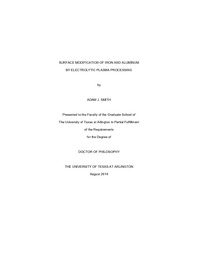
ATTENTION: The works hosted here are being migrated to a new repository that will consolidate resources, improve discoverability, and better show UTA's research impact on the global community. We will update authors as the migration progresses. Please see MavMatrix for more information.
Show simple item record
| dc.contributor.author | Smith, Adam J. | |
| dc.date.accessioned | 2016-01-28T18:19:30Z | |
| dc.date.available | 2016-01-28T18:19:30Z | |
| dc.date.issued | 2014 | |
| dc.date.submitted | 2014 | |
| dc.identifier.other | DISS-12829 | |
| dc.identifier.uri | http://hdl.handle.net/10106/25570 | |
| dc.description.abstract | Electrolytic Plasma Processing (EPP) is an emerging, clean surface modification technology which is able to both clean and, depending on the circuit polarity, deposit either cationic or anionic species from an aqueous electrolyte. EPP offers several benefits including environmental cleanliness, high deposition rates, and a nanograined surface structure. The following work presents research conducted on EPP, including surface cleaning of Fe and deposition of Ni onto Fe and Al substrates. Investigations were made into the microstructure of the surface as well as the atomic compositions of the coating and coating/substrate interface. EPP cleaning was initially conducted in order to determine optimum processing conditions for later work on EPP deposition as well as to determine the capabilities of the process.
EPP deposition of Ni onto Fe substrates was then conducted utilizing the process parameters determined from the EPP cleaning process. Coating thickness, deposition rate and coating coverage were determined and corrosion properties of the coated samples were then investigated. Best results were obtained for a deposition time of 30 s which resulted in a positive shift of the corrosion potential of 200 mV and a reduction of the corrosion rate of ~37%.
Research progressed to the application of EPP deposited Ni onto Al substrates. An investigation into the effect of deposition voltage onto coating quality and composition was conducted in order to determine optimum coating properties. Two processing conditions were chosen and were conducted at three separate deposition times: 185 V for 30 s, 60 s, or 90 s, and 210 V for 30 s followed by 30 s, 60 s, or 90 s at 185 V. Coating thickness, deposition rate and coverage were determined. Investigations into the mechanical properties, including hardness and tribological properties, and corrosion properties of the two conditions were conducted. It was determined that the coating process containing the initial 210 V step formed a discontinuous, intermetallic interlayer which proved to be beneficial to both the mechanical and corrosion properties of the samples. | |
| dc.description.sponsorship | Meletis, Efstathios I. | |
| dc.language.iso | en | |
| dc.publisher | Materials Science and Engineering | |
| dc.title | Surface modification of iron and aluminum by electrolytic plasma processing | |
| dc.type | Ph.D. | |
| dc.contributor.committeeChair | Jiang, Jiechao | |
| dc.degree.department | Materials Science and Engineering | |
| dc.degree.discipline | Materials Science and Engineering | |
| dc.degree.grantor | University of Texas at Arlington | |
| dc.degree.level | doctoral | |
| dc.degree.name | Ph.D. | |
Files in this item
- Name:
- out.pdf
- Size:
- 11.10Mb
- Format:
- PDF
This item appears in the following Collection(s)
Show simple item record


